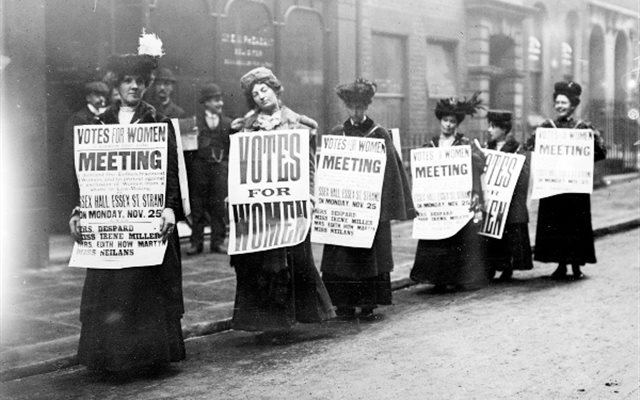100 years ago, women first gained the right to vote with the passing of the Representation of the People Act. Sarah Childs, Professor of Politics and Gender at Birkbeck, celebrates the centenary and looks at what still needs to change.
The celebrations and commemorations are well underway: there are numerous seminars, conferences and workshops; #Votes100 is trending on Twitter; and many of us are donning the colours of the suffragettes (purple, white and green) or the suffragists (green, white and red), and proudly displaying button pins and necklaces.
The centenary of the Representation of the People Act is 6 February 2018. The Act granted the vote to women over the age of 30 who met a property qualification and gave the vote to all men over the age of 21. Whilst we must wait until 2028 to celebrate women getting the vote on the same terms as men, it is definitely time to party – and drink our ‘Equaliteas’.
Perhaps a lesser known fact is that November will mark the centenary of the Parliament (Qualification of Women) Act, which gave women over 21 the right to stand for election as an MP. Again, we should celebrate (and who would object to another party?), but here we will need to be more circumspect. If democracy demands women’s enfranchisement there remains more to be done in respect of ‘Seats for Women’. The same is true in terms of realizing ‘Parliaments for Women’ and ‘Politics for Women’.
Seats for Women
The 2017 general election saw 208 women MPs elected to the UK House of Commons, the highest number ever. At 32% of all MPs, Westminster remains far from parity – and the 2% increase last year was paltry: 45% of all Labour MPs are women (119 of 262); the Conservatives saw fall-back, from 70 to 67, flat-lining at 21%. The Liberal Democrats have four women (33%) and the SNP 12 (34%). With political parties acting as the gatekeepers to Westminster, all must do more – political recruitment is best understood as a verb – and some should do more than others. Until then the ‘champagne should be left on ice’.
The most effective strategy to increase the numbers of women MPs is quotas. They may not be to everyone’s taste but follow the evidence: quotas deliver women into political office. The success of Labour’s All Women Shortlists and the Republic of Ireland’s quotas demonstrate this. In the Irish case, as Fiona Buckley has shown, the number of women candidates increased by 90% and the number of TDs elected – 35 (22%) – represents a 40% increase on the previous election.
As one of the two main political parties in the UK, the Conservatives have repeatedly resisted the logic of quotas and chosen not to make use of the legislation that permits their use until 2030. In Government, they have also rejected the quota recommendations of the Good Parliament Report and the 2016 Women and Equalities Committee Report on Women in Parliament. This isn’t good enough: the Conservatives saw a decline in their number of women MPs in 2017 and stood still in percentage terms. Political change – the upward trajectory of more women in Parliament – does not just happen. Quotas have to be put back on the table in 2018; and at the very least, the Government should commence Section 106 of the Equality Act 2010 so that public can hold the parties to account vis-a-vis the selection of parliamentary candidates. Let’s see which MPs sign Bernard Jenkin’s Early Day Motion, and which MPs choose to ignore the most minimal of requirements, namely, candidate diversity data transparency.
Parliament for Women
No-one, following the expose of sexual harassment at Westminster, can be under any illusion that Parliament is a gender-equal institution. The Good Parliament Report documented its diversity insensitivities and made 43 recommendations. The Commons Reference Group on Representation Inclusion, established and chaired by Mr Speaker, has been working since autumn 2016 on taking this agenda forward. Only last week the House agreed to the ‘Mother of the House’, Harriet Harman’s motion on baby leave. The Procedure Committee will now undertake an inquiry into how to best implement this. Securing leave for new parent MPs would be a belated, but nonetheless symbolic and substantive rule change that really would be something new to celebrate in 2018. ‘Anti’ mutterings have already been heard, and so attention must be given to the possibility of backlash.
Politics for Women
Our politics should address the concerns and views of women as well as men. Questions of who can act for women, and what acting for women means, is, however, contested in academic circles and amongst MPs. For some, good substantive representation (acting for women) means feminist substantive representation. For some, it means representation by women. But beware not to confuse women’s bodies with feminist minds; women do not come in one political hue; and men make representative claims ‘for women’. Political debate over the ‘good substantive representation’ is to be welcomed. It helps identify what is in the interests of women, has the potential to re-gender parties’ political programmes, and to deliver a better politics for all.
Politics should be something that ordinary women think about and do, ordinarily, as part of their everyday lives. Votes for women in 1918, and more so in 1928, redressed a basic political inequality. Redressing the gendered democratic deficits in respect of seats, political institutions and politics should be the ‘deeds’ of 2018; nice ‘words’ by political parties and by the Government will not suffice. Both should act, and it is not as if there isn’t a ‘shopping bag’ of reforms out there, ready to be picked up…and acted upon.



